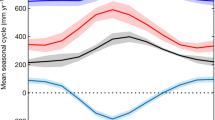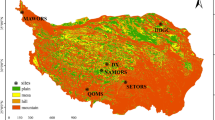Abstract
Recent studies have shown considerable changes in terrestrial evapotranspiration (ET) since the early 1980s, but the causes of these changes remain unclear. In this study, the relative contributions of external climate forcing and internal climate variability to the recent ET changes are examined. Three datasets of global terrestrial ET and the CMIP5 multi-model ensemble mean ET are analyzed, respectively, to quantify the apparent and externally-forced ET changes, while the unforced ET variations are estimated as the apparent ET minus the forced component. Large discrepancies of the ET estimates, in terms of their trend, variability, and temperature- and precipitation-dependence, are found among the three datasets. Results show that the forced global-mean ET exhibits an upward trend of 0.08 mm day−1 century−1 from 1982 to 2010. The forced ET also contains considerable multi-year to decadal variations during the latter half of the 20th century that are caused by volcanic aerosols. The spatial patterns and interannual variations of the forced ET are more closely linked to precipitation than temperature. After removing the forced component, the global-mean ET shows a trend ranging from −0.07 to 0.06 mm day−1 century−1 during 1982–2010 with varying spatial patterns among the three datasets. Furthermore, linkages between the unforced ET and internal climate modes are examined. Variations in Pacific sea surface temperatures (SSTs) are found to be consistently correlated with ET over many land areas among the ET datasets. The results suggest that there are large uncertainties in our current estimates of global terrestrial ET for the recent decades, and the greenhouse gas (GHG) and aerosol external forcings account for a large part of the apparent trend in global-mean terrestrial ET since 1982, but Pacific SST and other internal climate variability dominate recent ET variations and changes over most regions.













Similar content being viewed by others
Change history
17 October 2018
In the original publication of the article Fig. 7 was incorrect. The correct Fig. 7 is given below:
17 October 2018
In the original publication of the article Fig.��7 was incorrect. The correct Fig.��7 is given below:
17 October 2018
In the original publication of the article Fig.��7 was incorrect. The correct Fig.��7 is given below:
References
Angell JK (1993) Comparison of stratospheric warming following Agung, El Chichen and Pinatubo volcanic eruptions. Geophys Res Lett 20:715–718
Bretherton CS, Smith C, Wallace JM (1992) An intercomparison of methods for finding coupled patterns in climate data. J Clim 5:541–560
Collins M, Knutti R, et al. (2013) Long-term climate change: projections, commitments and irreversibility. In: Climate Change 2013: The physical science basis. Contribution of Working Group I to the Fifth Assessment Report of the Intergovernmental Panel on Climate Change [Stocker TF, Qin D, et al. (eds.)]. Cambridge University Press, Cambridge, United Kingdom and New York, NY, USA, pp. 1029–1136.
Dai A (2013) The influence of the inter-decadal Pacific oscillation on US precipitation during 1923–2010. Clim Dyn 41(3–4):633–646. doi:10.1007/S00382-012-1446-5
Dai A (2016) Historical and future changes in streamflow and continental runoff: A review. AGU Monograph entitled “Terrestrial Water Cycle and Climate Change: Natural and Human-induced Impacts”, Q. Tang et al. (eds.), in press.
Dai A, Wigley TML (2000) Global patterns of ENSO-induced precipitation. Geophys Res Lett 27(9):1283–1286. doi:10.1029/1999gl011140
Dai A, Fung IY, Del Genio AD (1997) Surface observed global land precipitation variations during 1900–1988. J Clim 10:2943–2962
Dai A, Qian T, Trenberth KE, Milliman JD (2009) Changes in continental freshwater discharge from 1949–2004. J Clim 22:2773–2791
Dingman SL (2015) Physical hydrology, 3rd edn. Waveland Press, Long Grove, p 643
Dong B, Dai A (2015) The Influence of the Interdecadal Pacific Oscillation on Temperature and Precipitation over the Globe. Clim Dyn:1–15. doi:10.1007/s00382-015-2500-x.
Feng S, Fu Q (2013) Expansion of global drylands under warming climate. Atmos Chem Phys 13:10081–10094
García-García D, Ummenhofer CC (2015) Multidecadal variability of the continental precipitation annual amplitude driven by AMO and ENSO. Geophys Res Lett 42(2):526–535
Gu G, Adler RF (2013) Interdecadal variability/long-term changes in global precipitation patterns during the past three decades: global warming and/or pacific decadal variability? Clim Dyn 39:3009–3022. doi:10.1007/s00382-012-1443-8
Gu G, Adler RF (2015) Spatial patterns of global precipitation change and variability during 1901-2010. J Clim 28:4431–4453. doi:10.1175/JCLI-D-14-00201.1
Gu G, Adler RF, Huffman GJ (2016) Long-term changes/trends in surface temperature and precipitation during the satellite era (1979-2012). Clim Dyn 46:1091–1105. doi:10.1007/s00382-015-2634-x
Harris I, Jones PD, Osborn TJ, Lister DH (2014) Updated high-resolution grids of monthly climatic observations – the CRU TS3.10 Dataset. Int J Climatol 34:623–642. doi:10.1002/joc.3711
Hu Q, Feng S (2012) AMO- and ENSO-Driven Summertime Circulation and Precipitation Variations in North America. J Climate 25(19):6477–6495. doi:10.1175/Jcli-D-11-00520.1
Jung M, Reichstein M, Ciais P, Seneviratne SI, Sheffield J, Goulden ML, Bonan G, Cescatti A, Chen JQ, de Jeu R, Dolman AJ, Eugster W, Gerten D, Gianelle D, Gobron N, Heinke J, Kimball J, Law BE, Montagnani L, Mu QZ, Mueller B, Oleson K, Papale D, Richardson AD, Roupsard O, Running S, Tomelleri E, Viovy N, Weber U, Williams C, Wood E, Zaehle S, Zhang K (2010) Recent decline in the global land evapotranspiration trend due to limited moisture supply. Nature 467(7318):951–954. doi:10.1038/Nature09396
Liu ZY (2012) Dynamics of interdecadal climate variability: a historical perspective. J Clim 25:1963–1995
Mantua NJ, Hare SR, Zhang Y, Wallace JM, Francis RC (1997) A Pacific interdecadal climate oscillation with impacts on salmon production. Bull Am Meteorol Soc 78:1069–1079. doi:10.1175/1520-0477(1997)078
Mao J, Fu W, Shi X, Ricciuto DM, Fisher JB, Dickinson RE, Wei Y, Shem W, Piao S, Wang K, Schwalm CR (2015) Disentangling climatic and anthropogenic controls on global terrestrial evapotranspiration trends. Environmental Research Letters 10(9):094008
Mintz Y, Walker GK (1993) Global fields of soil moisture and land surface evapotranspiration derived from observed precipitation and surface air temperature. J Appl Meteorol 32(8):1305–1334
Miralles DG, van den Berg MJ, Gash JH, Parinussa RM, de Jeu RAM, Beck HE, Holmes TRH, Jimenez C, Verhoest NEC, Dorigo WA, Teuling AJ, Dolman AJ (2014) El Nino-La Nina cycle and recent trends in continental evaporation. Nat Clim Change 4(2):122–126. doi:10.1038/Nclimate2068
Monahan AH, Fyfe JC, Ambaum MHP, Stephenson D, North GR (2009) Empirical orthogonal functions: The medium is the message. J. Climate 22:6501–6514
Myhre G, Shindell D, Bréon FM, Collins W, Fuglestvedt J, Huang J, Zhang H (2013) Anthropogenic and Natural Radiative Forcing. In: Climate Change 2013: The Physical Science Basis. Contribution of Working Group I to the Fifth Assessment Report of the Intergovernmental Panel on Climate Change [Stocker TF, Qin D, Plattner G-K, Tignor M, Allen SK, Boschung J, Nauels A, Xia Y, Bex V, Midgley PM (eds.)]. Cambridge University Press, Cambridge, United Kingdom and New York, NY, USA, pp. 659–740.
Nemani RR, Keeling CD, Hashimoto H, Jolly WM, Piper SC, Tucker CJ, Myneni RB, Running SW (2003) Climate-driven increases in global terrestrial net primary production from 1982 to 1999. Science 300(5625):1560–1563
Oleson K, Lawrence D, Bonan G, Drewniak B, Huang M, Koven C, Levis S, Li F, Riley W, Subin Z (2013) Technical description of version 4.5 of the Community Land Model (CLM). Ncar Tech. Note NCAR/TN-503 + STR. National Center for Atmospheric Research, Boulder, CO, 422 pp. doi: 10.5065/D6RR1W7M.
Pan S, Tian H, Dangal SR, Yang Q, Yang J, Lu C, Tao B, Ren W, Ouyang Z (2015) Responses of global terrestrial evapotranspiration to climate change and increasing atmospheric CO2 in the 21st century. Earth’s Future 3(1):15–35
Piao SL, Ito A, Li SG, Huang Y, Ciais P, Wang XH, Peng SS, Nan HJ, Zhao C, Ahlstrom A, Andres RJ, Chevallier F, Fang JY, Hartmann J, Huntingford C, Jeong S, Levis S, Levy PE, Li JS, Lomas MR, Mao JF, Mayorga E, Mohammat A, Muraoka H, Peng CH, Peylin P, Poulter B, Shen ZH, Shi X, Sitch S, Tao S, Tian HQ, Wu XP, Xu M, Yu GR, Viovy N, Zaehle S, Zeng N, Zhu B (2012) The carbon budget of terrestrial ecosystems in East Asia over the last two decades. Biogeosciences 9(9):3571–3586. doi:10.5194/Bg-9-3571-2012
Ropelewski CF, Halpert MS (1987) Global and regional scale precipitation patterns associated with the El Niño/Southern Oscillation. Mon Weather Rev 115(8):1606–1626
Ropelewski CF, Halpert MS (1989) Precipitation patterns associated with the high index phase of the Southern Oscillation. J Clim 2(3):268–284
Scheff J, Frierson DMW (2014) Scaling potential evapotranspiration with greenhouse warming. J Clim 27:1539–1558. doi:10.1175/JCLI-D-13-00233.1
Schneider U, Fuchs T, Meyer-Christoffer A, Rudolf B (2008) Global precipitation analysis products of the GPCC. Global Precipitation Climatology Centre (GPCC), Deutscher Wetterdienst: Offenbach, Germany. DWD, Internet Publikation 112. Available at http://gpcc.dwd.de.
Seo KW, Waliser DE, Tian B, Kim BM, Park SC, Cocke S, Sohn BJ, Ishii M (2012) Evidence of the recent decade Change in Global Fresh Water Discharge and Evapotranspiration Revealed by Reanalysis and Satellite Observations. Asia-Pac J Atmos Sci 48(2):153–158. doi:10.1007/S13143-012-0015-5
Taylor KE, Stouffer RJ, Meehl GA (2012) An overview of CMIP5 and the experiment design. Bull Am Meteorol Soc 93:485–498
Wang K, Dickinson RE (2012) A review of global terrestrial evapotranspiration: Observation, modeling, climatology, and climatic variability. Rev Geophys 50, RG2005, doi:10.1029/2011RG000373.
Wild M, Grieser J, Schär C (2008) Combined surface solar brightening and increasing greenhouse effect support recent intensification of the global land-based hydrological cycle. Geophys Res Lett 35:L17706. doi:10.1029/2008GL034842
Yan H, Yu Q, Zhu ZC, Myneni RB, Yan HM, Wang SQ, Shugart HH (2013) Diagnostic analysis of interannual variation of global land evapotranspiration over 1982-2011: Assessing the impact of ENSO. J Geophys Res-Atmos 118(16):8969–8983. doi:10.1002/Jgrd.50693
Zeng ZZ, Piao SL, Lin X, Yin GD, Peng SS, Ciais P, Myneni RB (2012) Global evapotranspiration over the past three decades: estimation based on the water balance equation combined with empirical models. Environ Res Lett 7(1). doi:Artn 014026.
Zhang Y, Wallace JM, Battisti DS (1997) ENSO-like interdecadal variability: 1900–1993. J Climate 10(5):1004–1020. doi:10.1175/1520-0442
Zhao T, Dai A (2015) The magnitude and causes of global drought changes in the 21st century under a low-moderate emissions scenario. J. Climate 28:4490–4512
Acknowledgments
We thank Dr. Diego Miralles for kindly providing the Miralles ET dataset. We acknowledge the World Climate Research Programme’s Working Group on Coupled Modelling, which is responsible for CMIP, and thank the international modeling groups and the Program for Climate Model Diagnosis and Intercomparison (PCMDI) for producing and making the CMIP5 data available. This work was supported by the U.S. National Science Foundation (Grant #AGS–1353740), the U.S. Department of Energy’s Office of Science (Award #DE–SC0012602), and the U.S. National Oceanic and Atmospheric Administration (Award #NA15OAR4310086).
Author information
Authors and Affiliations
Corresponding author
Rights and permissions
About this article
Cite this article
Dong, B., Dai, A. The uncertainties and causes of the recent changes in global evapotranspiration from 1982 to 2010. Clim Dyn 49, 279–296 (2017). https://doi.org/10.1007/s00382-016-3342-x
Received:
Accepted:
Published:
Issue Date:
DOI: https://doi.org/10.1007/s00382-016-3342-x




